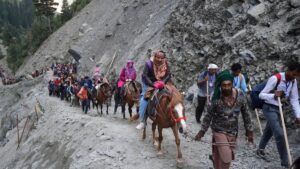Table of Contents
PM KUSUM Yojna
Context
Slow progress of PM-KUSUM Yojna has led to extension of its completion deadline to 2026
About PM-KUSUM Scheme
- PM-KUSUM stands for Prime Minister’s Kisan Urja Suraksha Evam Utthan Mahabhiyan, it was launched in 2019 under the Ministry of New and Renewable Energy (MNRE).
- The scheme aims to add Solar capacity of about 34,800 MW by March 2026 with the total Central Financial support of Rs 34,422 crore.
- The Scheme consists of three components:
- Component A: Setting up of 10,000 MW of Decentralised Ground/ Stilt Mounted Grid Connected Solar or other Renewable Energy based Power Plants by the farmers on their land
- Component B: Installation of 14 Lakh Stand-alone Solar Agriculture Pumps
- Component C: Solarisation of 35 Lakh Grid Connected Agriculture Pumps including Feeder Level Solarization
- Eligible categories for KUSUM Scheme are:
- An individual farmer.
- A group of farmers.
- FPO or Farmer producer organisation.
- Co-operatives.
- Water User Associations.
M-POX
Context
World Health Organisation has declared M-POX as public health emergency of international concern (PHEIC)
About M-POX
- It is a viral disease that primarily spreads to the human population through zoonotic spillovers, with rodents and primates serving as potential reservoirs.
- The first case in humans was reported in 1970 in the Democratic Republic of Congo.
- MPox is endemic to central and western Africa.
- It can be transmitted between humans through close contact and exposure to infected bodily fluids or lesions.
- Common symptoms: skin rash or mucosal lesions, Fever, rash and swollen lymph nodes which may lead to a range of medical complications.
- Detection of viral DNA by polymerase chain reaction (PCR) is the preferred laboratory test for Mpox.
- The Centre for disease control has recommended two vaccines to prevent Mpox: JYNNEOS and ACAM2000.
National Pest Surveillance System (NPSS)
Context
The Union government has launched NPSS powered by artificial intelligence (AI) to help farmers to connect with agriculture scientists and experts by mobile phones for controlling pests.
About NPSS
- NPSS is an AI-based platform launched by the Union Ministry of Agriculture and Farmer Welfare.
- It is designed to help farmers connect with agricultural scientists and experts for effective pest control using their phones.
- It aims to reduce farmers’ dependence on pesticide retailers.
- It provides data for selected crops i.e. Rice, Cotton, Maize, Mango and Chilies.
- Implementing Agency for the project: Directorate of Plant Protection, Quarantine & Storage, Faridabad
Californium Metal
Context
Bihar police recently seized a substance which they suspected to be 50 grams of Californium, a highly radioactive and valuable metal.
About Californium:
- Californium is a silvery-white synthetic radioactive metal with the atomic number 98 on the periodic table.
- It is highly radioactive and is a potent neutron emitter.
- It has a half-life of about 2.6 years for its most stable isotope, Californium-252.
- It is produced in nuclear reactors and particle accelerators by bombarding curium (another radioactive element) with neutrons.
- Uses of Californium
- used in portable metal detectors for identifying gold and silver ores,
- to help identify water and oil layers in oil wells
- detect metal fatigue and stress in aeroplanes.
- used in certain cancer treatments where targeted neutron therapy is required.
- Californium is extremely expensive, with a cost of around Rs 17 crore per gram in the international market.
Special Assistance to states for Capital Investment Scheme
Context
The Centre has decided to provide states with Rs 10,000 crore in incentives for implementing land-related reforms in rural and urban areas, and Rs 5,000 crore for creating a Farmers’ Registry during the financial year 2024-25.
About Special Assistance to states for Capital Investment Scheme
- The Scheme for Special Assistance to States for Capital Expenditure was launched in FY 2020-21 in the wake of Covid-19 Pandemic.
- The scheme has been expanded and continued as ‘Scheme for Special Assistance to States for Capital Investment 2023-24’ with allocation of Rs 1.3-lakh crore.
- The scheme has Eight Parts:
- Part-I being the largest with allocation of Rs. 1 lakh crore. This amount has been allocated amongst States in proportion to their share of central taxes & duties as per the award of the 15th Finance Commission.
- Other parts of the scheme are either linked to reforms or are for sector-specific projects.
- Part-II provides incentives to states for scrapping of old vehicles and setting up of automated vehicle testing facilities;
- Part-III and IV provide incentives to states for reforms in urban planning and urban finance;
- In urban areas, fiscal incentives will be provided for the digitization of land records using GIS mapping and the establishment of an information technology-based system for property record administration etc.
- Part-V provides funds for increasing the housing stock for police personnel and their families within the police stations in urban areas.
- Part-VI of the scheme supports Make in India and One District One Product by promoting cultural diversity and local products through Unity Mall projects.
- Under Part-VII, 5,000 crore is provided as financial assistance to states for establishing libraries with digital infrastructure at the Panchayat and Ward level.
Controlling Traffic-Related Air Pollution
Context
The 6th World Air Quality Report revealed the severity of air pollution in India.
Severity of Air Pollution in India
- Polluted Cities: India is home to 83 of the 100 most polluted cities globally.
- Health Impact: According to a report by the British Medical Journal, air pollution led to 2.1 million deaths in India, the second highest after China.
- Population Exposure: Over 99% of the Indian population breathes air that is below the World Health Organization (WHO) standards.
Sources Of Pollution
- Vehicular Emission: The International Energy Associates estimates that 12% of India’s CO2 emissions come from road transport.
- Example: Heavy vehicles are the major contributors to 5 (60-70%) and NOx (40-50%) emissions in urban areas.
- Energy Supply: The city’s air quality deteriorated drastically due to the increased use of coal and other fossil fuels for heating and power generation.
- Example: Coal-fired power plants discharge enormous quantities of SO2 and NOx, which are key elements for PM and ground-level ozone formation.
- Agricultural Practices: The burning of crop residues, particularly in states like Punjab and Haryana, leads to severe air pollution during the winter months, often contributing to the infamous smog in Delhi.
- The extensive use of fertilizers in agriculture leads to the release of ammonia (NH3) into the atmosphere, contributing to the formation of secondary particulate matter.
- The use of certain pesticides can also contribute to air pollution through the release of volatile organic compounds (VOCs).
- Waste Burning: In many parts of India, especially in urban slums and rural areas, the open burning of garbage is a common practice, releasing harmful pollutants like dioxins, furans, and other toxic chemicals into the atmosphere.
- Natural Sources:
- Dust Storms: Natural events like dust storms from the Thar Desert can contribute to elevated levels of particulate matter in the air, particularly in northern and western India.
- Forest Fires: Wildfires, particularly in forested regions like those in Uttarakhand and Himachal Pradesh, can lead to a significant increase in air pollution.
Measures Taken to Combat Air Pollution
- CAFE Norms: The Bureau of Energy Efficiency (BEE) has introduced Corporate Average Fuel Economy (CAFE) norms for cars.
- Timeline: CAFE III will be implemented from 2027-2032, and CAFE IV from 2032-2037.
- Testing Procedure: The transition from the Modified India Driving Cycle (MIDC) to the World Light Duty Vehicle Testing Procedure (WLTP) by March 31, 2027, is a significant step as WLTP offers a more accurate and globally harmonised measure of fuel consumption and CO2 emissions.
- CO2 Targets: The proposed emissions target for CAFE III is 91.7g CO2/km, and for CAFE IV, it is 70g CO2/km, which are achievable and necessary for driving innovation and cleaner technologies.
- Exclusions: These norms, however, exclude heavy vehicles like trucks and lorries.
- Vehicle Scrappage Policy:
- Implemented in 2022 to phase out old and polluting vehicles, including heavy vehicles.
- Requirements: Passenger vehicles older than 20 years and commercial vehicles older than 15 years must pass a fitness and emissions test.
- Challenges in Karnataka: The policy faces implementation issues in Karnataka due to the limited number of scrapyards (only two in the State) and its voluntary nature.
- Incentives in Maharashtra: Maharashtra offers incentives like discounts on road tax or new vehicle purchases to encourage scrapping, but the impact on air pollution remains limited.
- Existing Policies:
- Vehicle Emissions Testing: Regular testing of vehicles to ensure they remain within emission limits.
- Garbage Burning: Ban on open garbage burning.
- Industrial Emissions: Strict monitoring and control of industrial emissions.
Recommendations
- Mass Transit: The report concludes that mass transit systems are the only sustainable solution to address air pollution effectively in India.
- Stringent Implementation: Existing policies need to be enforced with greater rigour to ensure they effectively combat air pollution.


 Operation Shiva 2025: Indian Army’s Ma...
Operation Shiva 2025: Indian Army’s Ma...
 World Youth Skills Day 2025, Theme, Hist...
World Youth Skills Day 2025, Theme, Hist...
 President Murmu Nominates Four Members t...
President Murmu Nominates Four Members t...





















